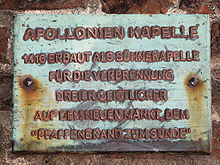Papenbrand thom Sunde
The Papenbrand thom Sunde ( burning of priests in Stralsund) occurred in 1407 in the Hanseatic city of Stralsund . Three priests were burned at a stake on the Neuer Markt by an angry population .
The citizens of the city of Stralsund had a quarrel with their chief clergyman, the lord of the St. Nikolai Church and the Tribsees provost , Cord Bonow . The chroniclers have two interpretations of the causes: Since it was customary at family celebrations for citizens to accompany special equipment of the celebrations with correspondingly high offerings for the church, the city council is said to have issued an ordinance against this behavior. Other interpretations indicate that the Stralsunders' willingness to make sacrifices in the churches has declined sharply.
In any case, Bonow was deeply disappointed and angry about the drop in income. At the head of an army of 400 warriors, whom he had recruited from his aristocratic relatives, he plundered the Stralsund Feldmark on October 6, 1407 . Not only was cattle stolen, but also murdered and burned . This behavior outraged the people of Stralsund, especially since they were also mocked by some clergymen. The very next day the people of Stralsund rebelled, first and foremost the members of the porters' trade who were most affected by the murders, and brought the clergy tied up before the judge in Neustadt . Since they were not allowed to judge clergy according to the then applicable law, the prisoners were driven into a house by the crowd, which they were supposed to set on fire. This could only be prevented by the council by pointing out the imminent danger to the neighboring houses. Thereupon three clergymen, namely the chaplain of St. Nikolai, the pastor of St. Marien and the pastor of St. Jakobi , who had been particularly noticeable for their wrongful behavior, were singled out from the crowd of clergy and burned on a stake .
This was not without consequences for the people of Stralsund. Since the city council refused to appear before the court of the responsible bishop Rudolf von Schwerin in Bützow , he announced the ban against the mayor, the city council and all Stralsund residents. All spiritual acts in Stralsund were prohibited by an interdict .
After unsuccessful attempts to change the bishop's mind, the city council turned directly to Pope Gregory XII. , a considerable sum of money in my luggage. This commissioned the bishop Nikolaus von Schippenbeil von Cammin with the lifting of the ban. However, the bishop turned against the papal instruction and even tightened the ban. In order to avert economic damage to the city (the bishop of Schwerin threatened the Stralsund trade through his relatives in Mecklenburg ), the council turned to Schwerin again. During a visit to the city in 1409, the latter imposed the penance on the Stralsunders to erect a stone atonement cross at the place of the priest's cremation in front of the house at Neuer Markt 14 and to build a chapel next to the Marienkirche (today's Apollonia Chapel ). The Stralsunders had to pay three vicarages , organize funeral celebrations and send three pilgrims to places of pilgrimage. In addition, the bishop's efforts to inaugurate the Stralsund churches and cemeteries had to be highly rewarded.
Cord Bonow received one of the vicarages from the bishop. The bishop only lifted the ban against those who were not involved in the cremation. However, the Stralsunders regularly ran the risk of being arrested outside of their city on the mere suspicion of complicity, even if it was only to gain economic advantages. The Stralsunders again turned to Gregor XII, and again they brought him great cash benefits. Gregory XII. thereupon excommunicated the bishop of Schwerin, who did not recognize this decision again.
The disputes were only settled in 1416, with the Stralsunders having to raise a large sum of money in addition to recognizing the Schwerin conditions of 1409. The bishop used this in the Schwerin Cathedral , in which since then a red inscription testifies to the bishop's victory: " Dith hebben de Sundeschen mothen buwen, datt se de papenn had burned " (the Stralsunders had to build this because they burned the priests ).
Pastor Cord Bonow was murdered in 1417 in Groß Kiesow near Greifswald by his neighbor in the Tribseer Land, the hereditary land marshal of Pommern-Wolgast Degener Buggenhagen , a partisan of the Hanseatic cities of Greifswald and Stralsund. It was the revenge for the murders and arson in the Stralsund Feldmark of 1407 that triggered the Papenbrand. In 1420, Degener von Buggenhagen was also murdered in Garbodenhagen near Stralsund - by Hennecke von Behr on behalf of the dowager duchess and regent Anna (the deed happened at the ducal table, where Degener went under the assurance of safe conduct). And finally the Hanseatic people took revenge on Hennecke von Behr himself, who was slain along with his followers in 1421, presumably at Usedom Castle ; his corpse was dragged through the city of Stralsund and then executed post mortem via bicycle weaving. This finally ended the political turmoil associated with the Papenbrand.
literature
- Konrad Fritze : Origin, rise and prosperity of the Hanseatic city of Stralsund. The "Papenbrand thom Sunde." In: Herbert Ewe (Ed.): History of the City of Stralsund , Hermann Böhlaus Nachsteiger, Weimar 1984, pages 76-80.


